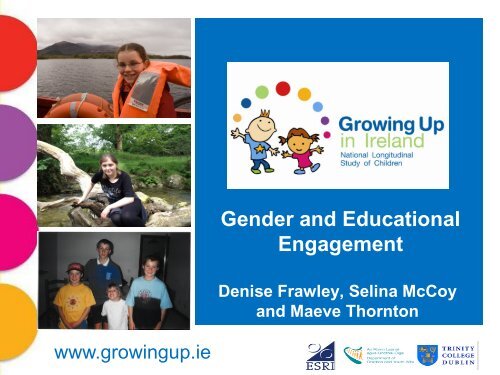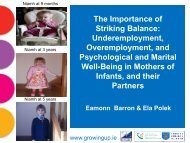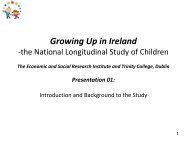Gender and Educational Engagement - Growing Up in Ireland
Gender and Educational Engagement - Growing Up in Ireland
Gender and Educational Engagement - Growing Up in Ireland
You also want an ePaper? Increase the reach of your titles
YUMPU automatically turns print PDFs into web optimized ePapers that Google loves.
<strong>Gender</strong> <strong>and</strong> <strong>Educational</strong><br />
<strong>Engagement</strong><br />
Denise Frawley, Sel<strong>in</strong>a McCoy<br />
<strong>and</strong> Maeve Thornton<br />
www.grow<strong>in</strong>gup.ie
Overview<br />
• Introduction to school engagement<br />
• <strong>Gender</strong> <strong>and</strong> engagement<br />
• What has GUI told us to date?<br />
• New f<strong>in</strong>d<strong>in</strong>gs<br />
• Overview of f<strong>in</strong>d<strong>in</strong>gs<br />
• Next steps
<strong>Engagement</strong><br />
• <strong>Engagement</strong> is a difficult concept to def<strong>in</strong>e<br />
• Broadly speak<strong>in</strong>g it can be def<strong>in</strong>ed as:<br />
o ‘the extent to which students identify with <strong>and</strong> value school<strong>in</strong>g<br />
outcomes, have a sense of belong<strong>in</strong>g at school, participate <strong>in</strong><br />
academic <strong>and</strong> non-academic activities, strive to meet the formal<br />
requirements of school<strong>in</strong>g, <strong>and</strong> make a serious personal<br />
<strong>in</strong>vestment <strong>in</strong> learn<strong>in</strong>g’ (Willms et al., 2009, p. 7)<br />
• School engagement is argued to be a key element of<br />
academic achievement, as well as lower<strong>in</strong>g the risk of<br />
negative behaviours like del<strong>in</strong>quency, aggression <strong>and</strong><br />
early school dropout (Fredricks et al., 2004; Hill <strong>and</strong><br />
Werner, 2006; Jimerson et al., 2003).
<strong>Engagement</strong> (2)<br />
• Historically the focus on engagement has been about<br />
improv<strong>in</strong>g academic <strong>and</strong> behavioural outcomes<br />
• Gradual move towards a more holistic view of student<br />
well-be<strong>in</strong>g <strong>and</strong> happ<strong>in</strong>ess<br />
• <strong>Engagement</strong> has become an important outcome <strong>in</strong> its<br />
own right<br />
• Most agree it comprises of the follow<strong>in</strong>g doma<strong>in</strong>s:<br />
o Academic<br />
o Behavioural<br />
o Affective<br />
o Cognitive
Types of engagement<br />
Observable engagement<br />
Less observable, self reported<br />
Academic<br />
Examples<br />
<strong>in</strong>clude:<br />
Behavioural<br />
Examples<br />
<strong>in</strong>clude:<br />
Affective<br />
Examples<br />
<strong>in</strong>clude:<br />
Cognitive<br />
Examples<br />
<strong>in</strong>clude:<br />
How often a<br />
student<br />
receives<br />
homework<br />
Attendance<br />
Student’s<br />
feel<strong>in</strong>gs<br />
Perception of<br />
school’s<br />
relevance<br />
Time spent<br />
on homework<br />
Active<br />
participation<br />
<strong>in</strong> class<br />
Sense of<br />
belong<strong>in</strong>g<br />
Motivation<br />
Academic<br />
results<br />
Participation<br />
<strong>in</strong> extracurricular<br />
activities<br />
Connection<br />
with school,<br />
parents <strong>and</strong><br />
teachers<br />
Expectations<br />
<strong>and</strong><br />
aspirations<br />
for the future<br />
Source: Furlong & Christenson (2008)
<strong>Gender</strong><br />
• Biological versus cultural determ<strong>in</strong>ants of sex<br />
differences - still a contentious issue<br />
• Most agree that it is a mixture of both<br />
• Social <strong>in</strong>stitutions <strong>and</strong> structures create <strong>and</strong><br />
perpetuate gender differences<br />
• Can also create differences where none might exist<br />
through biology<br />
• Children come to construct their own ideas about<br />
‘be<strong>in</strong>g a girl’ or ‘be<strong>in</strong>g a boy’
<strong>Gender</strong> & engagement<br />
• Research shows that boys <strong>and</strong> girls engage with<br />
school differently<br />
• The ‘gender gap’ focus has ma<strong>in</strong>ly been on the<br />
academic differences<br />
• ‘Moral panic’ around the underachievement of<br />
boys<br />
o ‘Clever girls outstrip boys’ (The Times 7 March 2009)<br />
o ‘Why do boys perform so much worse than girls <strong>in</strong><br />
exams?’ (Daily Telegraph 20 April 2008)
<strong>Gender</strong> & engagement<br />
• Boys shown to hold more negative feel<strong>in</strong>gs<br />
towards school than girls (Sir<strong>in</strong> & Sir<strong>in</strong>-Rogers,<br />
2005)<br />
• Why are boys more disengaged?<br />
o One prom<strong>in</strong>ent theory is the presence of a<br />
‘laddishness’ culture with<strong>in</strong> schools - boys viewed as<br />
‘problematic’, girls viewed as more ‘suited’ to school<br />
(Mac Na Ghaill, 1994; Mart<strong>in</strong>o, 1999)<br />
o But there are differences between boys <strong>and</strong> different<br />
ways of ‘do<strong>in</strong>g boy’
<strong>Gender</strong> & engagement<br />
• The ‘other side of the gender gap’ – girls still<br />
feel alienated (Warr<strong>in</strong>gton & Younger, 2000)<br />
• Evidence that while girls are less disruptive,<br />
they are more likely to experience anxiety,<br />
stress etc. (Jones & Myhill, 2010)<br />
• Much of the gender debate has focused on<br />
academic measures of engagement, with<br />
less attention given to other (more subtle,<br />
less observable) forms
What is known from<br />
GUI to date?<br />
• The study provides a vital evidence base for<br />
assess<strong>in</strong>g the impact of children’s primary<br />
school experiences on their long term<br />
outcomes<br />
• The results from GUI show important<br />
differences <strong>in</strong> school engagement among<br />
boys <strong>and</strong> girls, even at this relatively early<br />
age
Academic engagement<br />
• Boys are somewhat more likely to be <strong>in</strong> the lowest<br />
read<strong>in</strong>g qu<strong>in</strong>tile than girls (21% compared with 19%)<br />
• <strong>Gender</strong> patterns also emerged for Maths –<br />
significantly higher performance levels among boys<br />
than girls (23%; 17%).<br />
25<br />
20<br />
15<br />
10<br />
boys<br />
girls<br />
5<br />
0<br />
highest qu<strong>in</strong>tile maths<br />
lowest qu<strong>in</strong>tile read<strong>in</strong>g<br />
(Source: Williams et al., 2009)
Academic (2)<br />
• Homework completion<br />
o Boys were less likely to complete their homework<br />
than girls – 31% of boys came to school at least<br />
occasionally without hav<strong>in</strong>g their homework<br />
completed compared with 25% of girls (Williams et<br />
al., 2009)<br />
• Read<strong>in</strong>g for fun?<br />
o Boys report lower <strong>in</strong>cidence of read<strong>in</strong>g for fun than<br />
girls<br />
o 25% of boys read for fun everyday compared to 36%<br />
of girls<br />
o 8% of boys never read for fun compared to 3% of girls
Academic (3)<br />
• Teacher <strong>and</strong> parental expectations <strong>in</strong> maths<br />
do not match actual performance<br />
o Boys’ performance is overestimated while girls’<br />
performance - particularly the highest perform<strong>in</strong>g<br />
group - is underestimated (McCoy et al., forthcom<strong>in</strong>g)
Probability of Be<strong>in</strong>g Rated<br />
‘Excellent’ <strong>in</strong> Maths by Mother<br />
.2<br />
Predicted Probabilities<br />
for mothexc<br />
.15<br />
.1<br />
.05<br />
0<br />
-4 -2 0 2<br />
Low Score Drumcondra maths test - logit score High Score<br />
child gender<br />
female<br />
male
Probability of Be<strong>in</strong>g Rated<br />
‘Excellent’ or ‘Above Average’ <strong>in</strong><br />
Maths by Teacher<br />
1<br />
Predicted Probabilities<br />
for taexc<br />
.8<br />
.6<br />
.4<br />
.2<br />
0<br />
-4 -2 0 2<br />
Low Test Score Drumcondra maths test - logit score High Test Score<br />
child gender<br />
female<br />
male
Behavioural engagement<br />
• Children’s behavioural engagement with school has<br />
been measured through absenteeism & out-ofschool<br />
activities<br />
• Research has <strong>in</strong>dicated a significant relationship<br />
between school absenteeism <strong>and</strong> negative school<br />
outcomes (e.g. Kearney, 2003)<br />
• Moreover, children's <strong>in</strong>volvement <strong>in</strong> structured<br />
activities outside school has been found to<br />
enhance educational performance (e.g. Broh, 2002)
Behavioural (2)<br />
• ‘Emotional Behavioural Difficulties’ <strong>in</strong> boys<br />
o Higher <strong>in</strong>cidence among boys (Banks et al., 2011)<br />
o BUT evidence of ‘over identification’ of EBD <strong>in</strong> boys (Banks et<br />
al., 2012)<br />
• Out-of-school activities<br />
o Boys were more likely to engage <strong>in</strong> sports/computer games <strong>and</strong><br />
girls fell <strong>in</strong>to the cultural activities group (solitary activities, e.g.<br />
read<strong>in</strong>g for pleasure <strong>and</strong> organised activities - after school<br />
lessons or groups) <strong>and</strong> social networkers group (use computers<br />
for social network<strong>in</strong>g) (McCoy et al., 2012)
Affective engagement<br />
• Affective engagement is an <strong>in</strong>ternal <strong>in</strong>dicator that is<br />
less observable than academic or behavioural<br />
engagement<br />
• Student self-report measures are the most valid <strong>and</strong><br />
reliable way to capture this type of engagement<br />
• Measures used to reflect affective/cognitive aspects:<br />
o Child lik<strong>in</strong>g school<br />
o Child look<strong>in</strong>g forward to school<br />
o Child lik<strong>in</strong>g teacher<br />
o Child lik<strong>in</strong>g subjects
Affective (2)<br />
• Boys are two <strong>and</strong> a half times more likely to report<br />
that they never like school <strong>and</strong> three times more<br />
likely than girls to <strong>in</strong>dicate that they never like their<br />
teacher 18<br />
16<br />
14<br />
16<br />
12<br />
10<br />
8<br />
9.8<br />
9.1<br />
boys<br />
girls<br />
6<br />
5.9<br />
4<br />
2<br />
3.7<br />
3.1<br />
0<br />
Never like school Never look forward to school Never like teacher<br />
(Source: McCoy et al., 2009)
Affective (3)<br />
• In terms of school sett<strong>in</strong>g, it is not surpris<strong>in</strong>g to f<strong>in</strong>d<br />
that children attend<strong>in</strong>g boys’ only schools are less<br />
engaged than children attend<strong>in</strong>g other school<br />
sett<strong>in</strong>gs 100%<br />
90%<br />
80%<br />
9.1 6.7 4.7<br />
70%<br />
60%<br />
50%<br />
70.1<br />
67.1<br />
60.2<br />
Never like school<br />
Sometimes like school<br />
40%<br />
Always like school<br />
30%<br />
20%<br />
10%<br />
20.8<br />
26.2<br />
35.1<br />
0%<br />
s<strong>in</strong>gle-sex boys Co-educational S<strong>in</strong>gle-sex girls<br />
(Source: McCoy et al., 2009)
Affective (4)<br />
• Attitudes towards subjects<br />
o In terms of attitudes towards subjects, girls are more<br />
positive about English <strong>and</strong> Irish; boys are more<br />
positive about maths<br />
• These results raise concern over boys’ engagement<br />
with, <strong>and</strong> enjoyment of, school<strong>in</strong>g, with a potentially<br />
detrimental impact on their longer-term educational<br />
development <strong>and</strong> performance<br />
• What about other measures of affective<br />
engagement?
Research Aims<br />
• The vast majority of research studies focus on<br />
academic achievement (often def<strong>in</strong>ed as<br />
performance on st<strong>and</strong>ardised tests) but less is<br />
known about the factors shap<strong>in</strong>g student<br />
engagement <strong>and</strong> motivation<br />
• A range of outcomes should be considered<br />
• Children <strong>and</strong> young people themselves emphasise<br />
the affective (emotional) as much as the cognitive<br />
(learn<strong>in</strong>g) doma<strong>in</strong> <strong>in</strong> discuss<strong>in</strong>g their school<br />
experiences (Alex<strong>and</strong>er, 2008).<br />
• Important to go further <strong>and</strong> look at child reported<br />
self-concept
Data<br />
• Models use the 3 school-related Piers-Harris II<br />
Self-Concept subscales as outcome variables:<br />
o Behavioural adjustment (e.g. I am well behaved <strong>in</strong><br />
school, I do my homework)<br />
o Freedom from anxiety (e.g. I get worried when we<br />
have tests <strong>in</strong> school, I am often afraid)<br />
o Intellectual <strong>and</strong> school status (e.g. I am smart, In<br />
school I am a dreamer)<br />
• Independent variables <strong>in</strong>clude:<br />
o <strong>Gender</strong><br />
o socioeconomic background<br />
o performance qu<strong>in</strong>tiles<br />
o presence of a SEN <strong>and</strong> school characteristics
Low behavioural<br />
adjustment by gender<br />
• Research has shown that children who consider themselves to<br />
be poorly behaved can suffer from stigmatisation, peer<br />
rejection <strong>and</strong> lower self-evaluation (e.g. Keogh <strong>and</strong> MacMillan)<br />
• GUI shows that boys are more likely than girls to report very<br />
low <strong>and</strong> low levels of behaviour<br />
45<br />
40<br />
39.4<br />
41.8<br />
35<br />
30<br />
29.5<br />
25<br />
20<br />
15<br />
19.9<br />
11.4<br />
21.2<br />
17.3<br />
19.6<br />
boys<br />
girls<br />
10<br />
5<br />
0<br />
v. low/low low average average above average<br />
Behaviour
Low freedom from anxiety<br />
(high anxiety) by gender<br />
• International research has shown that girls are more likely than<br />
boys to display greater levels of anxiety about school work <strong>and</strong><br />
tests than boys (Locker & Cropley, 2004)<br />
• GUI supports the <strong>in</strong>ternational f<strong>in</strong>d<strong>in</strong>gs <strong>in</strong> that 18% of girls<br />
report very low & low levels of freedom from anxiety compared<br />
to 12 % of boys<br />
45<br />
41.1<br />
40<br />
35<br />
35.1<br />
36.3<br />
30<br />
28.5<br />
25<br />
20<br />
15<br />
18.4<br />
11.6 12.1<br />
16.8<br />
boys<br />
girls<br />
10<br />
5<br />
0<br />
v. low/low low average average above average<br />
Freedom from anxiety
Low <strong>in</strong>tellectual/school<br />
status by gender<br />
• Low <strong>in</strong>tellectual & school status is a measure of<br />
academic self-concept<br />
• GUI data shows slight gender differences<br />
45<br />
40<br />
35<br />
39.2<br />
40.6<br />
30<br />
25<br />
25.7<br />
26.4<br />
20<br />
15<br />
17.3 17.8<br />
14.7<br />
18.3<br />
boys<br />
girls<br />
10<br />
5<br />
0<br />
v. low/low low average average above average<br />
Intellectual & school status
Model 1: Family<br />
characteristics<br />
• Children from managerial backgrounds are less<br />
likely to report low self-concept across 3 measures<br />
• Newcomers (children whose parents were not born<br />
<strong>in</strong> Irel<strong>and</strong>) are more likely to report higher anxiety<br />
levels <strong>and</strong> lower academic self-concept
Low behavioural adjustment<br />
Add<strong>in</strong>g performance <strong>and</strong> gender<br />
(tak<strong>in</strong>g account of family characteristics)<br />
1<br />
0.8<br />
0.6<br />
0.4<br />
0.2<br />
0<br />
-0.2<br />
-0.4<br />
-0.6<br />
-0.8<br />
-1<br />
Qu<strong>in</strong>tile 1<br />
Qu<strong>in</strong>tile 2<br />
Qu<strong>in</strong>tile 3<br />
Qu<strong>in</strong>tile 4<br />
Qu<strong>in</strong>tile 5<br />
Qu<strong>in</strong>tile 1<br />
Qu<strong>in</strong>tile 2<br />
Qu<strong>in</strong>tile 3<br />
Qu<strong>in</strong>tile 4<br />
Qu<strong>in</strong>tile 5<br />
Multiple<br />
Learn<strong>in</strong>g disability<br />
EBD<br />
No SEN<br />
Male<br />
Female<br />
Maths Qu<strong>in</strong>tiles Read<strong>in</strong>g Qu<strong>in</strong>tiles SEN <strong>Gender</strong>
Low freedom from anxiety<br />
add<strong>in</strong>g performance & gender<br />
(tak<strong>in</strong>g account of family characteristics)<br />
0.8<br />
0.6<br />
0.4<br />
0.2<br />
0<br />
-0.2<br />
-0.4<br />
-0.6<br />
-0.8<br />
Qu<strong>in</strong>tile 1<br />
Qu<strong>in</strong>tile 2<br />
Qu<strong>in</strong>tile 3<br />
Qu<strong>in</strong>tile 4<br />
Qu<strong>in</strong>tile 5<br />
Qu<strong>in</strong>tile 1<br />
Qu<strong>in</strong>tile 4<br />
Qu<strong>in</strong>tile 5<br />
Multiple<br />
Learn<strong>in</strong>g disability<br />
EBD<br />
No SEN<br />
Male<br />
Female<br />
Maths Qu<strong>in</strong>tiles Read<strong>in</strong>g Qu<strong>in</strong>tiles SEN <strong>Gender</strong>
Low <strong>in</strong>tellectual & school status<br />
add<strong>in</strong>g performance <strong>and</strong> gender<br />
(tak<strong>in</strong>g account of family characteristics)<br />
0.4<br />
0.2<br />
0<br />
-0.2<br />
-0.4<br />
-0.6<br />
-0.8<br />
-1<br />
Qu<strong>in</strong>tile 1<br />
Qu<strong>in</strong>tile 2<br />
Qu<strong>in</strong>tile 3<br />
Qu<strong>in</strong>tile 4<br />
Qu<strong>in</strong>tile 5<br />
Qu<strong>in</strong>tile 1<br />
Qu<strong>in</strong>tile 2<br />
Qu<strong>in</strong>tile 3<br />
Qu<strong>in</strong>tile 4<br />
Qu<strong>in</strong>tile 5<br />
Multiple<br />
Learn<strong>in</strong>g disability<br />
EBD<br />
No SEN<br />
Male<br />
Female<br />
Maths Qu<strong>in</strong>tiles Read<strong>in</strong>g Qu<strong>in</strong>tiles SEN <strong>Gender</strong>
School characteristics<br />
Add<strong>in</strong>g DEIS & gender mix<br />
• Self-reported poor behaviour appears<br />
greater <strong>in</strong> rural DEIS schools<br />
• Self-reported anxiety is more prom<strong>in</strong>ent<br />
<strong>in</strong> s<strong>in</strong>gle-sex girls’ school
Discussion<br />
• F<strong>in</strong>d<strong>in</strong>gs show that boys <strong>and</strong> girls engage differently<br />
• Modest academic differences by gender at 9-years<br />
years of age<br />
• Behaviourally boys seem more disengaged than<br />
girls (e.g. Homework completion, read<strong>in</strong>g for fun etc)<br />
• Boys significantly more likely to never like school or<br />
their teacher <strong>and</strong> look forward to school<br />
• Look<strong>in</strong>g at self-concept...<br />
o Boys more likely to rate their behaviour as low<br />
o Boys more likely to rate their academic self-concept as low<br />
o Girls more likely to rate their freedom from anxiety as low
Discussion (2)<br />
• Other dimensions cross-cut gender <strong>in</strong> <strong>in</strong>fluenc<strong>in</strong>g<br />
engagement:<br />
o Newcomer children<br />
o SEN group<br />
o Lowest achiev<strong>in</strong>g performers <strong>in</strong> maths <strong>and</strong> read<strong>in</strong>g (high<br />
achiev<strong>in</strong>g group protected to some extent)<br />
o S<strong>in</strong>gle-sex girls’ schools re. anxiety<br />
• It is argued that we need to move beyond the<br />
academic debate <strong>and</strong> the assumption that all boys<br />
are struggl<strong>in</strong>g <strong>and</strong> all girls are do<strong>in</strong>g well<br />
• Complex area - about more than gender, it is about<br />
‘which’ boys <strong>and</strong> ‘which’ girls, <strong>and</strong> <strong>in</strong> what ways,<br />
they are disengaged
Next steps...<br />
• Need to look at the broader psycho-social outcomes<br />
of children’s educational engagement <strong>and</strong> move the<br />
focus beyond the academic ‘gender gap’<br />
• GUI data on 13-year-olds will allow us to look further<br />
at a broader range of outcomes <strong>and</strong> ask...<br />
o Do boys <strong>and</strong> girls differ <strong>in</strong> terms of school engagement as they<br />
move <strong>in</strong>to the teenage years?<br />
o How does earlier disengagement impact on later engagement<br />
<strong>and</strong> other educational outcomes?<br />
o What is the direction <strong>and</strong> causality of the relationships?<br />
• It is only by look<strong>in</strong>g at the data longitud<strong>in</strong>ally that we<br />
can see ‘which’ boys <strong>and</strong> ‘which’ girls are<br />
disengaged <strong>and</strong> <strong>in</strong> what ways
Thank you<br />
Any questions?












